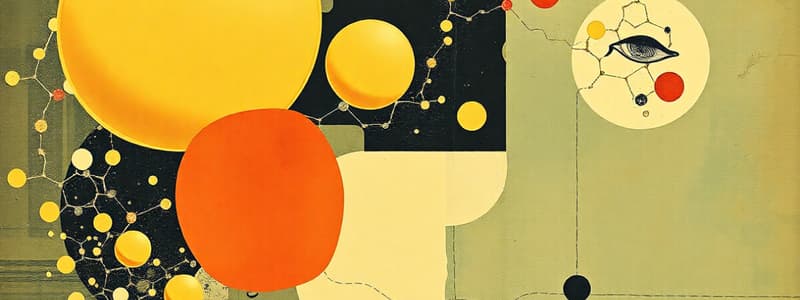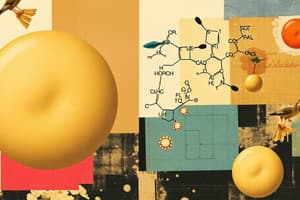Podcast
Questions and Answers
How do lipids differ from fats and oils?
How do lipids differ from fats and oils?
- Oils are organic compounds, while lipids and fats are inorganic.
- Fats are liquid at room temperature, while oils are solid.
- Lipids are a broader category, with fats being solid and oils being liquid at room temperature. (correct)
- Lipids are insoluble in organic solvents, while fats and oils are soluble.
Which of the following is a key characteristic that defines lipids?
Which of the following is a key characteristic that defines lipids?
- Containing only saturated fatty acids.
- High solubility in water.
- Relative insolubility in water and solubility in organic solvents. (correct)
- Being composed of amino acids.
Which of the following is NOT a major class of lipids?
Which of the following is NOT a major class of lipids?
- Phospholipids
- Fatty acids
- Amino acids (correct)
- Triglycerides
Which lipid class is characterized by a glycerol backbone?
Which lipid class is characterized by a glycerol backbone?
Which of the following is considered a 'storage lipid'?
Which of the following is considered a 'storage lipid'?
Which of the following lipid classes contains a carbohydrate component?
Which of the following lipid classes contains a carbohydrate component?
What is the fundamental structural difference between glycerophospholipids and sphingolipids?
What is the fundamental structural difference between glycerophospholipids and sphingolipids?
Which class of lipids has a basic structure consisting of a perhydrocyclo-pentanophenanthrene ring system?
Which class of lipids has a basic structure consisting of a perhydrocyclo-pentanophenanthrene ring system?
Which of the following describes the function of lipoproteins?
Which of the following describes the function of lipoproteins?
Which functional group is found at the alpha end of a fatty acid?
Which functional group is found at the alpha end of a fatty acid?
A fatty acid with 10 carbon atoms would be classified as which type of fatty acid?
A fatty acid with 10 carbon atoms would be classified as which type of fatty acid?
How does the length of a fatty acid's carbon chain affect its properties?
How does the length of a fatty acid's carbon chain affect its properties?
What structural feature defines a saturated fatty acid?
What structural feature defines a saturated fatty acid?
What is the difference between a monounsaturated and a polyunsaturated fatty acid?
What is the difference between a monounsaturated and a polyunsaturated fatty acid?
How are fatty acids categorized using the omega (ω) nomenclature?
How are fatty acids categorized using the omega (ω) nomenclature?
In systematic nomenclature, what does 'C18:1' indicate about a fatty acid?
In systematic nomenclature, what does 'C18:1' indicate about a fatty acid?
What does the 'Δ' symbol represent in the nomenclature of unsaturated fatty acids, such as in 'C18:Δ9'?
What does the 'Δ' symbol represent in the nomenclature of unsaturated fatty acids, such as in 'C18:Δ9'?
If a fatty acid is described as an omega-3 fatty acid, where is the first double bond located?
If a fatty acid is described as an omega-3 fatty acid, where is the first double bond located?
How does the number of double bonds in a fatty acid affect its physical nature?
How does the number of double bonds in a fatty acid affect its physical nature?
How do cis and trans fatty acids differ in structure?
How do cis and trans fatty acids differ in structure?
The omega (ω) nomenclature is specifically applicable to what type of fatty acids?
The omega (ω) nomenclature is specifically applicable to what type of fatty acids?
According to dietary guidelines, what is the recommended upper limit for saturated fatty acid (SFA) intake as a percentage of total kilocalories?
According to dietary guidelines, what is the recommended upper limit for saturated fatty acid (SFA) intake as a percentage of total kilocalories?
What is the primary dietary recommendation regarding trans-fatty acid consumption?
What is the primary dietary recommendation regarding trans-fatty acid consumption?
What chemical process leads to the formation of trans fatty acids in food production?
What chemical process leads to the formation of trans fatty acids in food production?
Which of the following represents the primary function of triglycerides?
Which of the following represents the primary function of triglycerides?
What are the products of triglyceride synthesis from glycerol and fatty acids?
What are the products of triglyceride synthesis from glycerol and fatty acids?
How is the solubility of a triacylglycerol (TAG) expected to compare to that of its parent fatty acid molecules?
How is the solubility of a triacylglycerol (TAG) expected to compare to that of its parent fatty acid molecules?
What is the role of adipocytes in the body?
What is the role of adipocytes in the body?
Which of the following describes a key feature of phospholipids?
Which of the following describes a key feature of phospholipids?
What is the key structural difference between a phospholipid and a triglyceride?
What is the key structural difference between a phospholipid and a triglyceride?
Which cellular structure contains a significant amount of phospholipids?
Which cellular structure contains a significant amount of phospholipids?
Which of the following describes the orientation of phospholipids when they form a bilayer in cell membranes?
Which of the following describes the orientation of phospholipids when they form a bilayer in cell membranes?
What type of compounds are derived from arachidonic acid and EPA?
What type of compounds are derived from arachidonic acid and EPA?
What roles do eicosanoids play in the body?
What roles do eicosanoids play in the body?
What effect does aspirin have on prostaglandin synthesis?
What effect does aspirin have on prostaglandin synthesis?
What is a key structural feature unique to sphingolipids?
What is a key structural feature unique to sphingolipids?
What distinguishes cerebrosides from other sphingolipids?
What distinguishes cerebrosides from other sphingolipids?
What is the primary role of glycosphingolipids on the cell surface?
What is the primary role of glycosphingolipids on the cell surface?
What structural characteristic is common to all sterols?
What structural characteristic is common to all sterols?
What role does cholesterol play in animal cells?
What role does cholesterol play in animal cells?
What is a cholesteryl ester?
What is a cholesteryl ester?
Flashcards
Lipids
Lipids
Organic substances insoluble in water, soluble in organic solvents.
Fats
Fats
Lipids that are solid at room temperature.
Oils
Oils
Lipids that are liquid at room temperature.
Fatty Acids
Fatty Acids
Signup and view all the flashcards
Triglycerides
Triglycerides
Signup and view all the flashcards
Phospholipids
Phospholipids
Signup and view all the flashcards
Glycolipids
Glycolipids
Signup and view all the flashcards
Eicosanoids
Eicosanoids
Signup and view all the flashcards
Steroids
Steroids
Signup and view all the flashcards
Lipoproteins
Lipoproteins
Signup and view all the flashcards
Fatty acid composition
Fatty acid composition
Signup and view all the flashcards
Short-chain fatty acids
Short-chain fatty acids
Signup and view all the flashcards
Medium chain fatty acids
Medium chain fatty acids
Signup and view all the flashcards
Long-chain fatty acids
Long-chain fatty acids
Signup and view all the flashcards
Fatty Acid Chain Length
Fatty Acid Chain Length
Signup and view all the flashcards
Saturated fatty acids
Saturated fatty acids
Signup and view all the flashcards
Unsaturated fatty acids
Unsaturated fatty acids
Signup and view all the flashcards
Monounsaturated
Monounsaturated
Signup and view all the flashcards
Polyunsaturated
Polyunsaturated
Signup and view all the flashcards
Alpha (α) Nomenclature
Alpha (α) Nomenclature
Signup and view all the flashcards
Omega (ω) Nomenclature
Omega (ω) Nomenclature
Signup and view all the flashcards
Cis double bond
Cis double bond
Signup and view all the flashcards
Trans double bond
Trans double bond
Signup and view all the flashcards
Beta-oxidation
Beta-oxidation
Signup and view all the flashcards
Monoglycerides
Monoglycerides
Signup and view all the flashcards
Diglycerides
Diglycerides
Signup and view all the flashcards
Triglycerides
Triglycerides
Signup and view all the flashcards
Triglyceride function.
Triglyceride function.
Signup and view all the flashcards
Adipocytes
Adipocytes
Signup and view all the flashcards
Subcutaneous adipose tissue
Subcutaneous adipose tissue
Signup and view all the flashcards
Visceral adipose tissue
Visceral adipose tissue
Signup and view all the flashcards
Phospholipids
Phospholipids
Signup and view all the flashcards
Amphipathic
Amphipathic
Signup and view all the flashcards
Glycerophospholipids
Glycerophospholipids
Signup and view all the flashcards
Phosphatidate
Phosphatidate
Signup and view all the flashcards
Eicosanoids
Eicosanoids
Signup and view all the flashcards
Sphingolipids
Sphingolipids
Signup and view all the flashcards
Cerebroside
Cerebroside
Signup and view all the flashcards
Sterols
Sterols
Signup and view all the flashcards
Cholesterol
Cholesterol
Signup and view all the flashcards
Study Notes
- Lipids are organic compounds relatively insoluble in water but soluble in organic solvents.
Fats vs Oils
- Fats are solid at room temperature whereas oils are liquid at room temperature.
Major Lipid Classes
- Fatty acids
- Triglycerides
- Phospholipids
- Sterols
- Fat-soluble vitamins
Classes of Lipids
- Fatty acids - long chain linear (unbranched) hydrocarbons with carboxylic acids
- Triglycerides - fatty acid esters of glycerol
- Phospholipids - lipids containing one or more phosphate groups
- Glycolipids - lipids containing a carbohydrate component
- Eicosanoids - derivatives of Arachidonic acid
- Steroids - possess a perhydrocyclo-pentanophenanthrene ring system
- Lipoproteins - complexes of lipids and proteins circulating in the blood
Fatty Acid Structure
- Consists of a chain of carbon atoms
- Has a carboxylic acid group at the alpha end (-COOH)
- Possesses a methyl group at the omega end
Number of Carbons
- Short-chain fatty acids: < 8 carbons
- Medium-chain fatty acids: 8-12 carbons
- Long-chain fatty acids: > 12 carbons
Fatty Acid Chain Length
- Chain length impacts a fatty acid’s chemical properties, physiological functions, and water solubility.
Saturation
- Saturated fatty acids feature single carbon-carbon bonds.
- Unsaturated fatty acids exhibit double bonds.
- Monounsaturated fatty acids contain one double bond.
- Polyunsaturated fatty acids have ≥2 double bonds.
Fatty Acid Nomenclature
- Alpha (α) Nomenclature: Based on double bond positions relative to the carboxylic (α) end.
- Omega (ω) Nomenclature: Categorizes fatty acids based on the first double bond relative to the methyl (ω) end, uses "n" system.
Double Bond Position
- For unsaturated fatty acids, abbreviations clarify double bond locations in molecules.
- In "C18: Δ9", the double bond starts at the 9th carbon from the carboxyl end.
- In the abbreviated form can written as C18: Δ9, 12, sometimes written as C18: 2Δ9, 12.
- If there is redundancy nbb bonds in fats are separated by a methylene group -C-.
Examples of Specific Fatty Acids
- Omega-3 fatty acid: The first double bond is between the 3rd and 4th carbons from the ω end.
- Omega-6 fatty acid: The first double bond is between the 6th and 7th carbons.
Double Bonds
- The number of double bonds influences a fatty acid's physical nature.
- Saturated fatty acids (SFA) are solid at room temperature.
- Monounsaturated (MSFA) are thick liquids or soft solids.
- Polyunsaturated (PSFA) are liquid.
Cis vs Trans
- Cis double bond: Hydrogen atoms are on the same side of the double bond.
- Trans double bond: Hydrogen atoms are on opposite sides of the double bond, resulting in the name being "Trans fatty acid"
Common Names
- Refer to the table for common names and food sources of important saturated and unsaturated fatty acids.
Naming fatty acids
- This includes Caproic (C6:0) - Caproyl. Caprylic (C8:0) - Caprylyl. Capric (C10:0) - Capryloyl. Lauric (C12:0) - Lauroyl. Myristic (C14:0) - Myristoyl. Palmitic (C16:0) - Palmitoyl. Palmitoleic (C16:∆9) - Palmitoleoly. Stearic(C18:0) - Steroyl. Oleic (C18:∆9) - Oleoyl. Linoleic(C18:∆9, 12) - Linoleoyl. Linolenic(C18:∆9, 12, 15) - Linolenoyl. Arachidonic(C20:∆5,8,11, 14) - Arachidonyl, DHA, and EPA.
Naturally Occuring Fatty Acids
- Double bonds in fatty acids usually have the cis configuration.
- Most naturally occurring fatty acids have an even number of carbon atoms.
- Examples: 14:0 myristic acid, 16:0 palmitic acid, 18:0 stearic acid, 18:1 cisΔ9 oleic acid, 18:2 cisΔ9,12 linoleic acid, 18:3 cisΔ9,12,15 α-linonenic acid, palmitoleic acid 16:1cisΔ9, 20:4 cisΔ5,8,11,14 arachidonic acid, 20:5 cisΔ5,8,11,14,17 eicosapentaenoic acid (an omega-3).
β-Oxidation of Fatty Acids
- Process releases energy from fatty acids
ATP Determination
- Process determines ATP yield from fatty acid beta oxidation.
- Example Formula: 17 + 17 + 17 + 12 – 2 = 61 ATP
ATP Formulas
- For even chains, ATPs produced = (17 * C – 10)/2 – 2 ATP.
- For odd chains, ATPs produced = [(17 * C – 51) + 6]/2 – 3.
- Remember to subtract 2 ATP if the C=C starts at an odd carbon, and 3 ATP if C=C starts at an even carbon
Beta Oxidations
- Where the fatty acid has an odd number of carbons. The last chop results in a three carbon molecule producing 6 ATPs. - 3 ATPs of activation energy.
Essential Fatty Acids
- The essential fatty acids for the diet are: Alpha-Linolenic acid (18:3) - ω-3 and Linoleic acid (18:2) - ω-6
- Cannot be synthesized by humans because lack desaturase enzymes.
- Used to created longer and more desaturated fatty acids.
Food
- Alaskan natives' diets high in ω-3 fatty acids from fish and marine mammals are related to enhanced physiological responses stimulated by ω-3 eicosanoids.
Sources of Essential Fatty Acids
- Linoleic acid: Nuts & seeds
- Linolenic acid: Oils (soybean, safflower, corn, flaxseed)
- EPA & DHA: Fatty fish & seafood
- Arachidonic acid: Variety of plant & animal foods
Essential Fatty Acid Deficiency
- Results in: Irritated & flaky skin, Gastrointestinal problems, Compromised immune system and Slow growth for children
SFA Guidelines
- Guidelines advise limiting saturated fatty acids.
- High intake correlates with cardiovascular disease risk.
- Dietary Guidelines for Americans suggest SFAs should be limited to no more than 10% of total kilocalories.
Trans Fat
- During partial hydrogenation, the process converts carbon-carbon double bonds found in PUFAs are converted to single bonds
- This forms trans fatty acids and reduces spoilage and improves texture.
- Food sources include shortening, margarine, crackers, pastries, and bakery products.
- Guidelines limit trans-fatty acid intake due to cardiovascular risks.
- The U.S. Dietary Guidelines recommend consuming less than 1% of kilocalories from trans fatty acids.
- Required on food labels from 2006>.
Mono-, Di-, & Triglycerides
- All are a Source of energy (ATP), insulation, protection
- Monoglycerides: Lipid is made of a glycerol bonded to 1 fatty acid
- Diglycerides: Lipid is made of a glycerol bonded to 2 fatty acids
- Triglycerides: Lipid is made of a glycerol bonded to 3 fatty acids
Triacylglycerols
- Triacylglycerols are are the simplest lipids where the 3 -OH groups of glycerol are each esterified to a fatty acid, unless all are the same, in “tripalmitin”, a name and position of each must be given
Functions of Triglycerides
- Provide body essential fatty acids.
- Is needed for Energy production, Insulation and Protection
Energy
- Adipocytes are specialized cells in adipose tissue used as an energy reserve
- Subcutaneous adipose tissue is found directly under the skin
- Visceral adipose tissue surrounds vital organs
- Large amounts of triglycerides can be stored as energy in a small space
- Lipids have Body has high energy yield
- Body has infinite ability to store excess energy in adipose tissue
Adipose
- Insulates the body and protects internal organs
Phospholipids
- Major components of cell membranes roles in digestion, absorption, transport of lipids, cellular metabolism
- Is both Amphipathic as it Contains both polar and nonpolar portions
Phosphatidate
Is the most basic phopholipid from which other other kinds are based
Glycerophospholipids
(phosphoglycerides), are common constituents of cellular membranes hydroxyls at C1 & C2 are Hydroxyls (OH) and esterfied to fatty acids
- An ester forms when a hydroxyl interacts with a carboxylic acids releasing water
Lipoproteins
Carry hydrophobic compounds
Sources
- Naturally found in most foods and is a Stabilizer to foods Mayonnaise & ice cream Soy products is Commenly called “lecithin”
Phospholipids & Mental Health
- Influences ability to think, speak, reason, remember & move and is Found and essential in neural development & function.
Studying That Suits You
Use AI to generate personalized quizzes and flashcards to suit your learning preferences.




